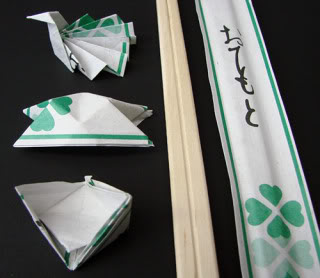Chopsticks are eating utensils that are a pair of small, tapered sticks that are used as the traditional eating utensils of Japan,
| China, Vietnam, Korea, and Taiwan. It’s thought that they originated in ancient China and then spread throughout Asia. The most common materials used to make chopsticks are bamboo or plastic, but you can also find ones made of metal, ivory, bone, and several different types of wood. I’ve got two different videos here that both show you |
how to use chopsticks–I like having multiple videos teaching the same thing, IF they’re both good, because when you’re trying to learn something seeing two different teaching perspectives can really help, plus the first one is aimed at using chopsticks the Chinese way and teaches some Chinese chopstick etiquette and the second one is aimed at using chopsticks the Japanese way and teaches some Japanese etiquette. Grab your chopsticks and have a look (do it the Karate Kid way: when you can catch a fly with your chopsticks, you are ready to eat out at Asian restaurants without fear of embarrassing yourself  ):
):
How to use chopsticks the Chinese way
Some additional notes on Chinese chopstick etiquette:
- It’s considered acceptable (and a polite gesture) to transfer food to close relatives (e.g. grandparents, parents, spouse, children, etc.) who are having difficulty picking up their food. Also, it is a sign of respect to pass food to any elderly people at the table first before everyone else.
- Don’t tap chopsticks on the edge of your bowl: beggars do this to attract attention.
- Don’t point rested chopsticks towards other people who are seated at the table.
How to use chopsticks the Japanese way
Some additional notes on Japanese chopstick etiquette
- Don’t transfer food from your chopsticks to someone else’s chopsticks. Japanese people will always offer or pass their plate to transfer food. Transferring directly is how bones are passed as part of Japanese funeral rites.
- Place the pointed ends of your chopsticks on a chopstick rest when they’re not being used. However, when a chopstick rest is not available, as is usually the case in most restaurants (which use ‘waribashi’: disposable chopsticks), what you can do is make one by folding the paper case that contained the chopsticks into an improvised sort of rest, like this:

- Don’t cross your chopsticks on the table, as this symbolizes death, or vertically stick them in the rice, which is done during a funeral.
- As with the Chinese, the Japanese consider it rude to rub wooden chopsticks together after breaking them apart, because this says to the host that you think the chopsticks are cheap.
- Don’t hold the chopsticks in your mouth while you do something else like pick up a bowl or plate.
- Don’t use unmatched chopsticks.
- Don’t wash your chopsticks off in your soup or beverage.
- Don’t use chopsticks as hair accessories. Everyone has seen photos of kimono-clad Japanese models and geishas with what appear to be pretty chopsticks in their hair. Those are not chopsticks, they are hair ornaments called kanzashi. Chopsticks are exclusively for use with your food.
Additional Resources and Further Reading
If you want my personnel recommendation for an excellent set of chopsticks for use at home, the best choice by far are these Yamazaki stainless steel chopsticks that I got from Amazon–they’re only about $10, they’re super easy to wash and clean because they’re stainless steel, and they come with a lovely travel case to store them in.
Here’s how to do a cool chopstick trick called ‘floating chopstick’.
How to pimp your chopsticks at PandaPassport.com’s China Blog.